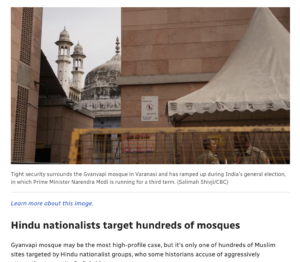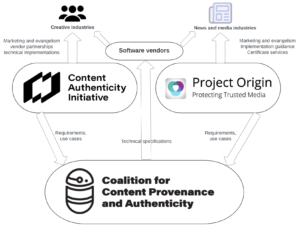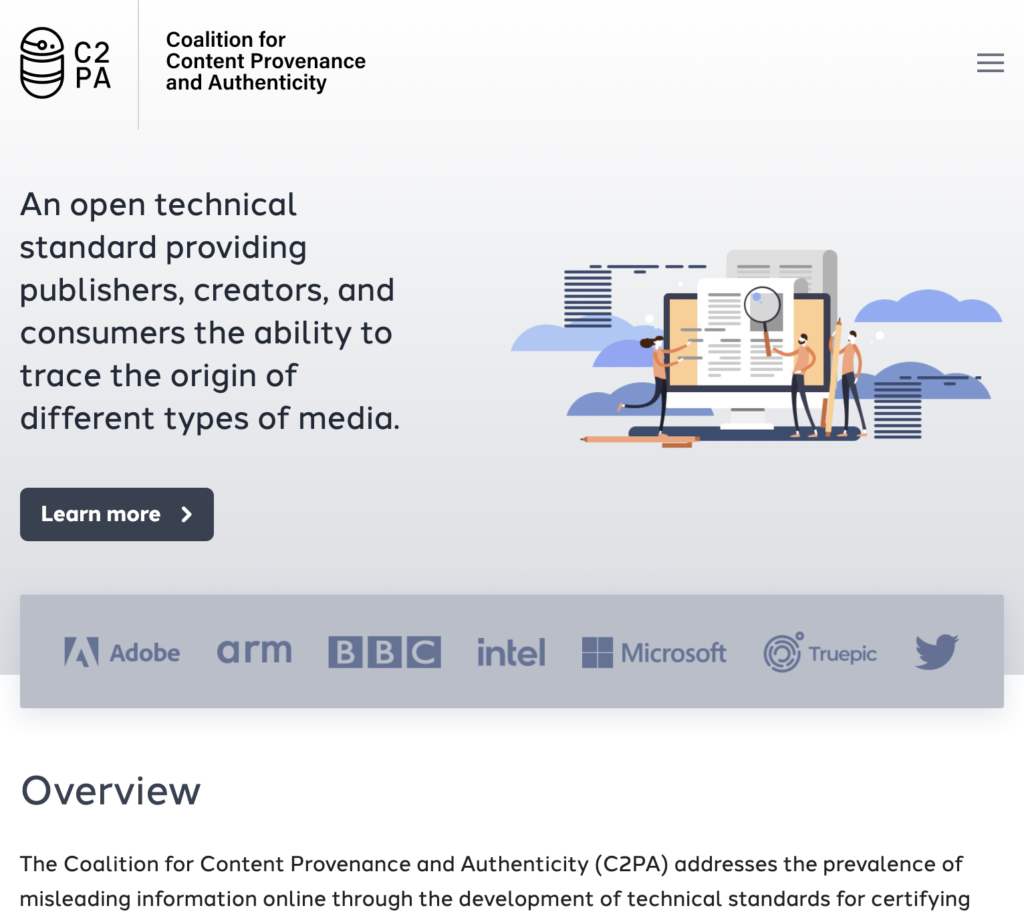Categories
Archives

A few months in, things are going very well for the IPTC’s new Media Provenance Committee.
The IPTC Committee was initiated to continue the work started by Project Origin to bring the benefits of C2PA provenance technology to the news media industry. The Committee is chaired by Bruce MacCormack of CBC / Radio Canada.
The Committee has initiated three Working Groups who will be looking at specific issues:
- The Provenance Governance Working Group, led by Charlie Halford of the BBC.
- The Provenance Best Practices and Implementation Working Group, led by Helge O. Svela of Media City Bergen.
- The Provenance Advocacy and Education Working Group, led by Judy Parnall of the BBC.
We have also started the process of onboarding participants for the next phase of the Origin Verified News Publishers List, and have had several organisations already apply.
The first publishers on the list, BBC and CBC/Radio Canada, have already published some C2PA-signed content:
- The BBC has published some images and video with C2PA-embedded metadata showing the fact-checking process that has been undertaken by the BBC Verify fact-checking team.
- CBC / Radio Canada has published images signed with the CBC certificate on the cbc.ca website.
We are planning several events in the future to promote our work and encourage more in the media industry to get involved. Look out for news about IPTC Media Provenance work at the IBC Conference in Amsterdam in September and at other events.
If your organisation would like to be added to the list in the next phase or in the future, please get in touch!

The International Press Telecommunications Council, in conjunction with Project Origin, has established a working group to create and manage a C2PA compatible list of verified news publishers.
The open C2PA 2.0 Content Credentials standard for media provenance is widely supported as a strong defence against misinformation. Recent announcements by OpenAI, Meta, Google and others have confirmed the value of an interoperable, tamper-evident way of confirming the source and technical integrity of digital media content.
Project Origin, as a co-founder of the C2PA, has brought the needs of the news publishing community to the forefront of the creation of this standard. This now includes the creation of a C2PA 2.0 compatible Origin Verified Publisher Certificate to be used by publishers to securely create a cryptographic seal on their content. The signing certificates will be available through the IPTC, who will work with C2PA validators to gain widespread acceptance. These signing certificates will be issued by the IPTC to broadcast, print and digital native media publishers.
Origin Verified Publisher Certificates will ensure that the identity of established news organisations are protected from imposters. The certificates confirm organisational identity and do not make any judgement on editorial position. Liaison agreements with other groups in the media ecosystem will be used to accelerate the distribution of certificates.
The initial implementation uses TruePic as a certificate authority, with the BBC and CBC/Radio-Canada as trial participants.
“As a founding partner of Project Origin, CBC/Radio-Canada is proud to be one of the first media organisations to trial Origin Verified Publisher Certificates,” said Claude Galipeau, Executive Vice-President, Corporate Development, CBC/Radio-Canada. “This initiative will provide our audiences with a new and easy way of confirming that the content they’re consuming is legitimately from Canada’s national public broadcaster. It’s an important step in our adoption of the Content Credentials standard and in our fight against misinformation and disinformation.”
Jatin Aythora, Director of BBC R&D, and vice chair for Partnership on AI, said “Media provenance increases trust and transparency in news, and so is an essential tool in the fight against disinformation. That fight has never been more important, and so we hope many more media organisations will join us in securing their own Origin Verified Publisher Certificate.”
Publishers interested in working cooperatively to advance the implementation of the C2PA standard in the news ecosystem are invited to join the Media Provenance Committee of the IPTC.
For further information please contact:
- Judy Parnall – judy.parnall@bbc.co.uk – representing the BBC
- Bruce MacCormack – bruce@neuraltransform.com – representing CBC/Radio-Canada
- Brendan Quinn – mdirector@iptc.org – representing the IPTC

The IPTC is proud to announce that after intense work by most of its Working Groups, we have published version 1.0 of our guidelines document: Expressing Trust and Credibility Information in IPTC Standards.
The culmination of a large amount of work over the past several years across many of IPTC’s Working Groups, the document represents a guide for news providers as to how to express signals of trust known as “Trust Indicators” into their content.
Trust Indicators are ways that news organisations can signal to their readers and viewers that they should be considered as trustworthy publishers of news content. For example, one Trust Indicator is a news outlet’s corrections policy. If the news outlet provides (and follows) a clear guideline regarding when and how it updates its news content.
The IPTC guideline does not define these trust indicators: they were taken from existing work by other groups, mainly the Journalism Trust Initiative (an initiative from Reporters Sans Frontières / Reporters Without Borders) and The Trust Project (a non-profit founded by Sally Lehrman of UC Santa Cruz).
The first part of the guideline document shows how trust indicators created by these standards can be embedded into IPTC-formatted news content, using IPTC’s NewsML-G2 and ninjs standards which are both widely used for storing and distributing news content.
The second part of the IPTC guidelines document describes how cryptographically verifiable metadata can be added to media content. This metadata may express trust indicators but also more traditional metadata such as copyright, licensing, description and accessibility information. This can be achieved using the C2PA specification, which implements the requirements of the news industry via Project Origin and of the wider creative industry via the Content Authenticity Initiative. The IPTC guidelines show how both IPTC Photo Metadata and IPTC Video Metadata Hub metadata can be included in a cryptographically signed “assertion”
We expect these guidelines to evolve as trust and credibility standards and specifications change, particularly in light of recent developments in signalling content created by generative AI engines. We welcome feedback and will be happy to make changes and clarifications based on recommendations.
The IPTC sends its thanks to all IPTC Working Groups that were involved in creating the guidelines, and to all organisations who created the trust indicators and the frameworks upon which this work is based.
Feedback can be shared using the IPTC Contact Us form.

Following the recent announcements of Google’s signalling of generative AI content and Midjourney and Shutterstock the day after, Microsoft has now announced that it will also be signalling the provenance of content created by Microsoft’s generative AI tools such as Bing Image Creator.
Microsoft’s efforts go one step beyond those of Google and Midjourney, because they are adding the image metadata in a way that can be verified using digital certificates. This means that not only is the signal added to the image metadata, but verifiable information is added on who added the metadata and when.
As TechCrunch puts it, “Using cryptographic methods, the capabilities, scheduled to roll out in the coming months, will mark and sign AI-generated content with metadata about the origin of the image or video.”
The system uses the specification created by the Coalition for Content Provenance and Authenticity. a joint project of Project Origin and the Content Authenticity Initiative.
The 1.3 version of the C2PA Specification specifies how a C2PA Action can be used to signal provenance of Generative AI content. This uses the IPTC DigitalSourceType vocabulary – the same vocabulary used by the Google and Midjourney implementations.
This follows IPTC’s guidance on how to use the DigitalSourceType property, published earlier this month.
We had a great Photo Metadata Conference last Thursday. Thanks to those who attended. For those who didn’t, or those who would like to go over some detail again, here we publish full recordings of all sessions.
First up, Brendan Quinn, IPTC Managing Director introduced the day and gave an overview of what was to come:
Next was a great panel on adoption of the accessibility properties added in the 2021.1 update to the IPTC Photo Metadata Standard. We are very happy to share that the fields are now supported in many popular photo creating and editing tools, with more to come:
Next was David Riecks and Michael Steidl, co-leads of the IPTC Photo Metadata Working Group, presenting the work done by the Working Group since the last Photo Metadata Conference:
Then came a session on real-world implementations of the C2PA specification for content authenticity, including presentations from Microsoft, CBC / Radio Canada, the BBC and Adobe / Content Authenticity Initiative:
The last session was a panel discussion on Metadata for AI Images, looking at questions around the ethics of using copyrighted content to train a machine learning engine to generate AI images, and how the IPTC Photo Metadata Standard could be extended to support metadata appropriate for AI-generated images:
We had a great session and a packed conference! We look forward to seeing everyone again at next year’s event.

We are happy to announce that IPTC’s work with C2PA, the Coalition for Content Provenance and Authority, continues to bear fruit. The latest development is that C2PA assertions can now include properties from both the IPTC Photo Metadata Standard and our video metadata standard, IPTC Video Metadata Hub.
Version 1.2 of the C2PA Specification describes how metadata from either the photo or video standard can be added, using the XMP tag for each field in the JSON-LD markup for the assertion.
For IPTC Photo Metadata properties, the XMP tag name to be used is shown in the “XMP specs” row in the table describing each property in the Photo Metadata Standard specification. For Video Metadata Hub, the XMP tag can be found in the Video Metadata Hub properties table under the “XMP property” column.
We also show in the example assertion how the new accessibility properties can be added using the Alt Text (Accessibility) field which is available in Photo Metadata Standard and will soon be available in a new version of Video Metadata Hub.

We are proud to announce that Camera Bits, Mobius Labs, Microsoft, Smithsonian, CBC and many others will be presenting at the IPTC Photo Metadata Conference next week, Thursday 10th November. With a theme of Photo Metadata in the Real World, the event is free for anyone to attend. Register here for the Zoom webinar to receive details before the event.
The event will run from 1500 UTC to 1800 UTC. The full agenda with timings is published on the event page.
We will start off with a short presentation on recent updates to the IPTC Photo Metadata Standard from David Riecks and Michael Steidl, co-leads of the IPTC Photo Metadata Working Group. This will include the new properties approved at the recent IPTC Autumn Meeting.
A session on Adoption of IPTC Accessibility properties will include speakers from Smithsonian, Camera Bits (makers of the photographers tool Photo Mechanic), Picvario presenting their progress implementing IPTC’s accessibility properties, announced at last year’s Photo Metadata Conference.
The next session will be Software Supporting the IPTC Photo Metadata Standard, where Michael Steidl and David Riecks, co-leads of the IPTC Photo Metadata Working Group, present their work on IPTC’s database of software supporting the Photo Metadata Standard, and the IPTC Interoperability tool, showing compatibility between tools for individual properties.
Use of C2PA in real-world workflows is the topic of the next session, demonstrating progress made in implementing C2PA technology to make images and video tamper-evident and to establish a provenance trail for creative works. Speakers include Nigel Earnshaw and Charlie Halford from the BBC, David Beaulieu and Jonathan Dupras from CBC/Radio Canada, Jay Li from Microsoft, and a speaker yet to be confirmed from the Content Authenticity Initiative.
The next session should be very exciting: Metadata for AI images will be the topic, featuring an introduction to synthetic media and “generative AI” images, including copyright and ownership issues behind the images used to train the machine learning models involved, from Brendan Quinn and Mark Milstein.
Then we have a panel session: How should IPTC support AI and generative models in the future? Questions to be covered include whether we should identify which tool, text prompt and/or model was used to create a generative image? Should we include a flag that indicates content was created using a “green”, copyright-cleared set of training images? And perhaps other questions too – please come along to ask your own questions! Speakers include Dmitry Shironosov, Everypixel / Dowel.ai / Synthetics.media, Martin Roberts from Mobius Labs and Sylvie Fodor from CEPIC. The session will be moderated by Mark Milstein from vAIsual.
Last year we had over 200 registrants and very lively discussions. We look forward to even more exciting presentations and discussions this time around! See you there. (Please don’t forget to register!)
As previously announced, the IPTC are participating in the Coalition for Content Provenance and Authenticity (C2PA) project to create a specification to tackle online disinformation and misinformation.

After months of work by the C2PA Technical Working Group, the first public draft of the specification has been released. In particular, the spec defines how properties from the IPTC Photo Metadata Standard can be included in a C2PA manifest, creating a provenance trail that allows future viewers to validate the authenticity of a claim associated with a media asset (such as the location the photo was taken, the creator’s name or who is the person in a photo).
The full press release from C2PA follows:
SAN FRANCISCO, Calif. — September 1, 2021 — Today, the Coalition for Content Provenance and Authenticity (C2PA), a Joint Development Foundation project established to scale trust in online content, released its content provenance specifications – in draft form – for community review and feedback. Driven by a commitment to tackle online disinformation, the C2PA’s technical specifications are designed to be an open standard that will allow publishers, creators and consumers to trace the origin and evolution of a piece of media, including images, videos, audio and documents.
“C2PA was established to accelerate progress toward the broad adoption of content provenance standards that will enable a future of verifiable integrity in media,” said Andrew Jenks, C2PA Chair. “The release of this draft is an exciting and important milestone, representing a diverse and collaborative effort across industries to protect people from fabricated and manipulated media and drive transparency in the origin and history of content.”
Combatting online content fraud at scale requires transparency and an accessible and open approach that enables consumers to make informed decisions about what has been modified and what has not. The C2PA was launched in February 2021 with founding members Adobe, Arm, BBC, Intel, Microsoft and Truepic with the goal of developing an end-to-end open technical standard to address the rise of disinformation efforts leveraging tools for media fabrication and manipulations. The effort has expanded, bringing in additional members including Twitter, WITNESS, Akamai and Fastly.
Over the past six months, the C2PA has worked with industry experts and partner organizations, including the Project Origin Alliance and the Content Authenticity Initiative (CAI), to develop a standard for digital provenance that provides platforms with a method to define descriptive metadata, what information is associated with each type of asset, how that information is presented and stored, and how evidence of tampering can be identified. This group of contributors spans a spectrum of industries including social media, news publishing, software technology, semiconductors and more. All have contributed to building these new technical specifications through a process of gathering requirements, considerations of scenarios and technical design.
Following the review period, the C2PA working groups will finalize the 1.0 version of the technical standards and once published, the group will pursue adoption, prototyping and communication through coalition members and other external stakeholders, providing the foundation for a system of verifiable provenance on the internet.
“The power of C2PA’s open standard will rely on its broad adoption by producers and custodians of content, which makes this review phase so critical to the development and finalization of the specifications,” said Jenks. “This is why we are making the draft specification available to the public. We encourage rigorous review and feedback across industries, civil society, academia, and the general public to ensure the C2PA standards reflect the complex nature of this effort.”
The draft specification can be accessed through the C2PA website, and comments will be accepted through a web submission form and GitHub until November 30, 2021.
C2PA is accepting new members. To join, visit https://c2pa.org/membership/.
About C2PA
The Coalition for Content Provenance and Authenticity (C2PA) is an open, technical standards body addressing the prevalence of misleading information online through the development of technical standards for certifying the source and history (or provenance) of media content. C2PA is a Joint Development Foundation project, formed through an alliance between Adobe, Arm, BBC, Intel, Microsoft and Truepic. For more information, visit c2pa.org.